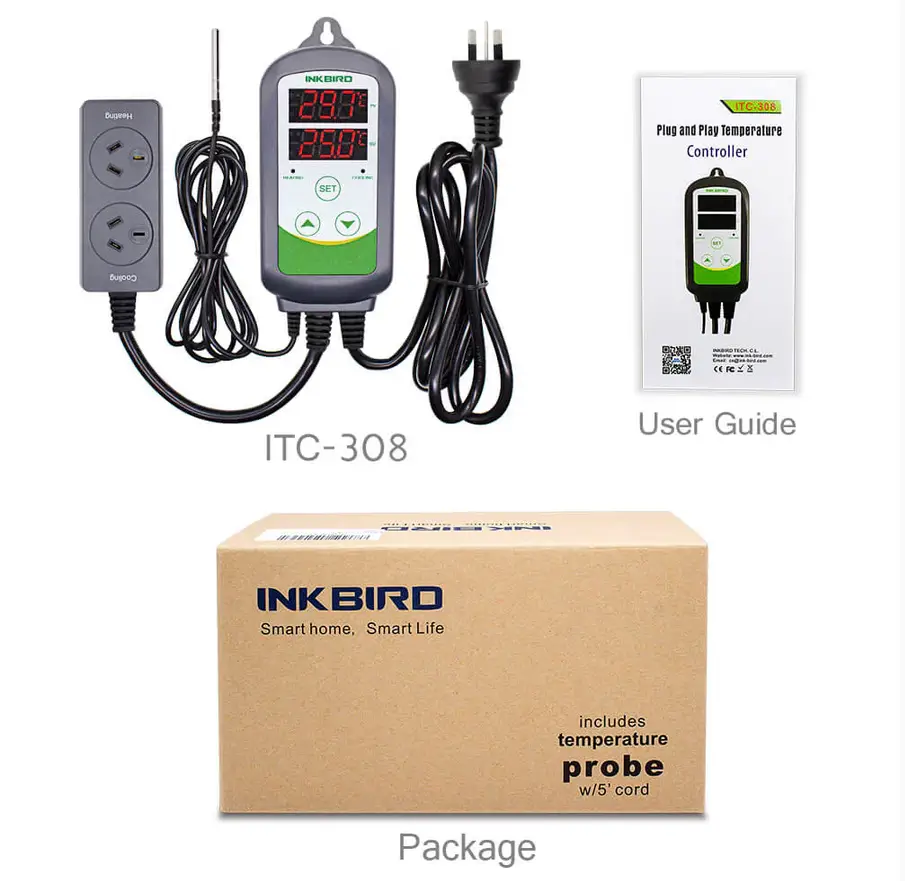This page may contain affiliate links that allow us to make a small commission from qualifying purchases (at no extra cost to yourself). We appreciate your support.
In the captivating world of reptile care, providing the ideal environment for your scaly companions goes beyond just setting up a vivarium with the right decor. As cold-blooded creatures, reptiles rely heavily on external sources of heat to regulate their body temperature. This is where the pivotal role of a reptile thermostat comes into play. But do you really need one?
If you own a reptile, then a reptile thermostat is needed. It ensures that the habitat remains within the specific temperature range required by the particular species. As reptiles are cold-blooded creatures, this is crucial for the reptile’s overall well-being, as it allows them to effectively regulate their metabolic functions and behavior.
In this article, we’ll delve into the importance of reptile thermostats, exploring the reasons why they are more than just an accessory and uncovering the benefits they bring to both your reptiles and you as a responsible and caring keeper. Whether you’re a seasoned reptile enthusiast or a curious beginner, understanding the significance of a reptile thermostat is absolutely key.
So, if you’re all about fostering a thriving and harmonious habitat for your reptiles, stick around – this one’s for you!
Is a Reptile Thermostat Necessary?
Absolutely! Reptile thermostats are an important device used to regulate the temperature in your reptile’s enclosure. Temperature regulation allows reptiles to carry out essential biological processes, such as digestion and immune system function. Failure to provide the right temperature range can lead to stress, lethargy, and even health issues, making temperature control a fundamental aspect of responsible reptile care.
At its core, a reptile thermostat is like the guardian of your scaly friend’s comfort zone.
Imagine this: reptiles are cold-blooded, meaning they depend on external sources of warmth to regulate their body temperature. That’s where the thermostat swoops in.
It’s a nifty device that keeps tabs on the temperature within their enclosure and makes sure it stays in the Goldilocks range – not too hot, not too cold, but just right.
What is the Best Thermostat for a Vivarium?
The best thermostat for a reptile vivarium can vary depending on your specific needs, budget, and the type of reptile you are caring for. My personal favorite is the ITC-308 by INKBIRD.
As you all know, I only recommend brands and products that I use myself and INKBIRD temperature controllers have consistently proven to be reliable, reasonably priced, and versatile.
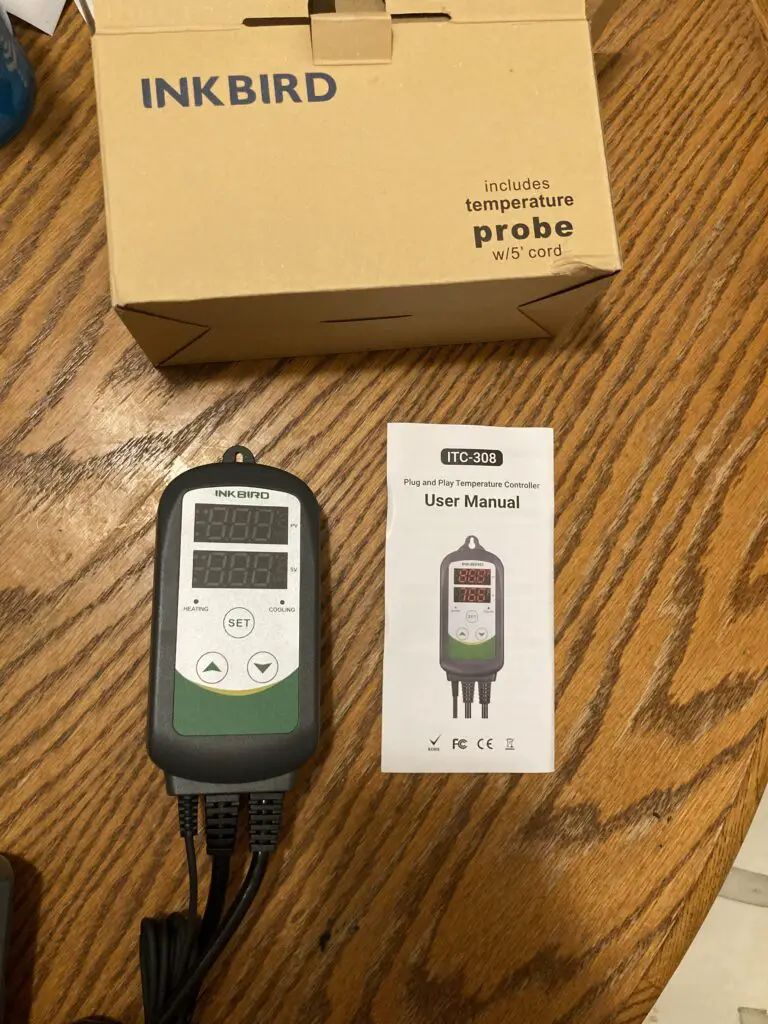
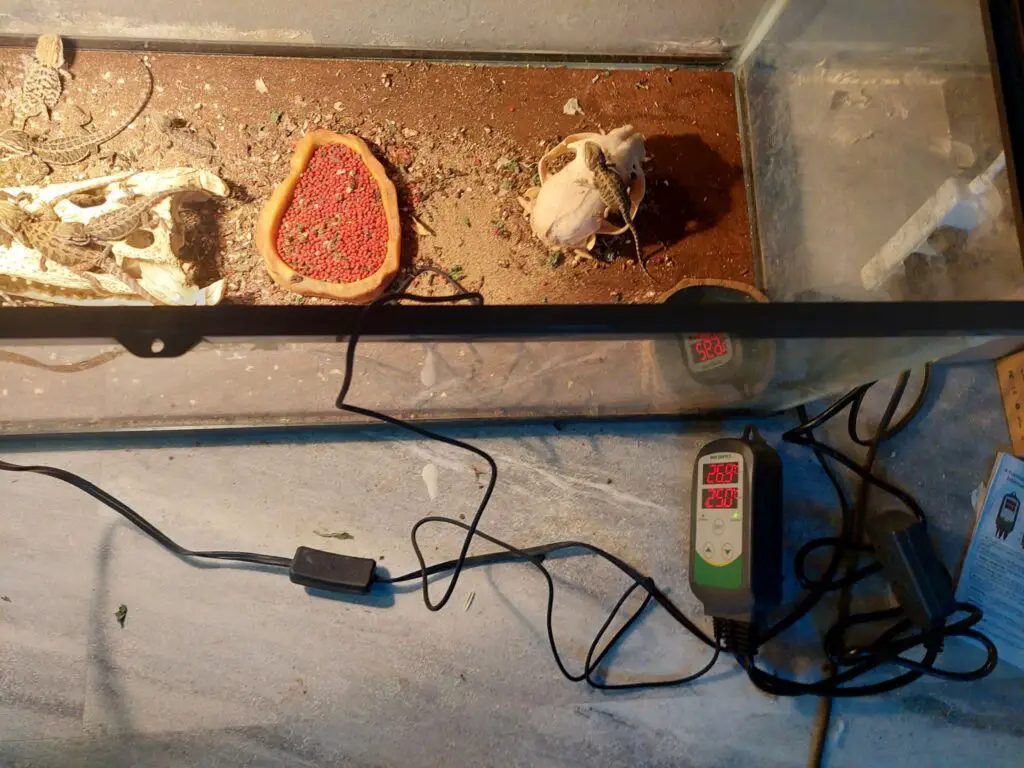
The reason why I absolutely swear by this thermostat is because it’s tailored perfectly to meet my reptiles’ unique needs:
First and foremost, it’s all about precision. I need to know that my reptiles can lounge in their ideal warm spots and cool off when they please, and this thermostat has that down to a science.
- an impressive temperature control range of -58°F to 248°F
- Temperature accuracy within 2°F
Plus, it’s a breeze to use. Even someone relatively new to reptile keeping, could effortlessly set and tweak the settings without a hitch.
- Easy of use straight out of the box
- Supports °C/°F display
- Temperatures displayed and set simultaneously
- Heating/Cooling separate settings
But what really seals the deal for me is the peace of mind it offers. With its alarms and safety features, I can relax knowing that it’s always looking out for my reptiles, ready to alert me if anything goes amiss.
- Compressor delay protection
- A buzzer alarm for high and low temperatures and abnormal probe performance
- Great Lifetime customer support (this is a big one for me as I hate bad support teams)
In a nutshell, this thermostat isn’t just a gadget; it’s become an essential part of my reptile family, ensuring they thrive in an environment that’s just right for them.
If you’re in the market for a reptile thermostat yourself, the INKBIRD ITC-308 Digital Thermostat can be purchased directly through the INKBIRD website or through Amazon below:

Another reason why I love the INKBIRD brand is they also have products for a variety of uses in the smart controller space. INKBIRD is a smart IoT brand offering excellent smart home living products to the global markets. So if you’re interested in alternative uses for their reptile thermostat, or if you just want to upgrade other areas of your home, checkout their website, INKBIRD.com.
Best Placement for a Vivarium Thermostat
The thermostat in the vivarium should be located close to and beneath the heat lamp to ensure that it is easy to monitor and adjust. Keeping the thermostat probe under the heat lamp towards the center of the vivarium will help with fast and accurate temperature checks and adjust the reptile’s environment quickly.
If you’re using a heating pad outside your vivarium to provide your reptile friend with some extra warmth, there’s one crucial thing to keep in mind: safety.
To ensure that the heating pad doesn’t get too hot, it’s essential to plug a thermostat into it. This way, you can maintain a safe temperature range for your reptile friend and avoid any overheating mishaps.
When it comes to the thermostat probe placement, there’s no better spot than beneath the heat lamp in the basking area. This will give you an accurate reading of the temperature and help you gauge how warm your pet reptile is feeling.
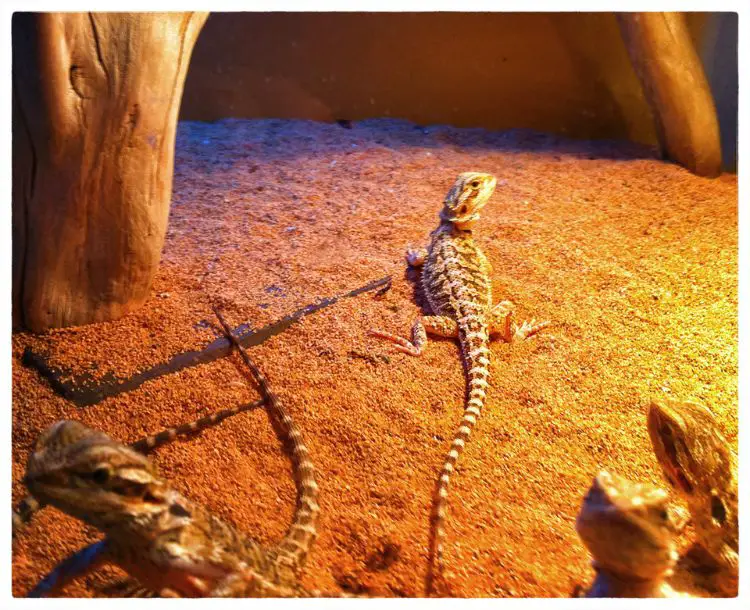
Believe me, you don’t want to miss the sight of your scaley buddy basking under the heat lamp, with the thermostat right by their side. It’s a moment of pure joy that’ll warm your heart and make all the hard work worth it.
Now, here’s a pro-tip: avoid placing the thermostat probe in a spot that’s hard to read or easy to forget about. Placing it behind foliage or other decorations in the vivarium may obscure your view of the reading, making it harder to monitor the temperature.
So, make sure you have a clear view of the thermostat probe and keep it in a spot where you won’t forget to check it regularly. Trust me, your scaly friend will thank you for it!
For a more in depth guide regarding thermostat placement and other important questions, be sure to check out this other article I wrote using the link above.
What Temperature Should My Reptile’s Tank Be?
The ideal temperature for your reptile’s tank depends on the species you’re caring for, as different reptiles have specific temperature requirements based on their natural habitats.
Below I have put together some general guidelines based on common reptile groups and a select few of my favorite reptiles that are often kept as pets.
Don’t forget – always consult care sheets or seek advice from experienced reptile keepers or veterinarians for precise temperature recommendations for your particular species.
Desert Reptiles
| Animal | Temperature Range | Basking Temperature Range | Relative Humidity Range |
|---|---|---|---|
| General Guidelines | 70-90°F | 90-105°F | 10-40% |
| Bearded Dragon | 70-85°F | 95-110°F | 30-40% |
| Leopard Gecko | 75-85°F | 90-95°F | 30-40% |
| Horned Lizard | 70-80°F | 100-105°F | 60-80% |
| Rosy Boa | 65-85°F | 90-95°F | 40-60% |
| Uromastyx | 80-90°F | 110-130°F | 10-25% |
Temperate Reptiles
| Animal | Temperature Range (°F) | Basking Temperature Range (°F) | Relative Humidity Range (°F) |
|---|---|---|---|
| General Guidelines | 65-80°F | 85-95°F | 50-70% |
| Garter Snake | 75-85°F | 90-95°F | 50-60% |
| Ball Python | 75-85°F | 88-95°F | 60-70% |
| Box Turtle | 65-75°F | 85-90°F | 60-80% |
| Rubber Boa | 65-75°F | 80-85°F | 50-60% |
| Corn Snake | 75-80°F | 85-90°F | 40-50% |
Tropical Reptiles
| Animal | Temperature Range (°F) | Basking Temperature Range (°F) | Relative Humidity Range (°F) |
|---|---|---|---|
| General Guidelines | 70-80°F | 85-95°F | 60-80% |
| Iguana | 80-90°F | 95-100°F | 70-80% |
| Green Tree Python | 70-80°F | 85-90°F | 40-70% |
| Chameleon | 70-85°F | 85-95°F | 65-80% |
| Anole | 65-75° | 85-90°F | 60-80% |
| Red-Eyed Crocodile Skink | 70-75°F | 80-82°F | 70-80% |
Remember to use a reliable thermometer or temperature gun to monitor temperatures accurately. Additionally, a good-quality reptile thermostat (Like INKBIRD’s ITC-308) can help maintain the desired temperatures consistently, ensuring the health and well-being of your reptile friend.
4 Things to be Aware of When Using a Reptile Thermostat
1. Reptile Temperature Too Cold
When reptiles get too cold, they start to slow down and become immobile. This affects their ability to eat and digest food, to hold onto branches, and to function in general. Just like us humans who tend to get sick in the winter months, reptiles will also be more susceptible to illness if their temperature drops below the recommended range.
2. Reptile Temperature Too Hot
One of the biggest symptoms of your reptile overheating is dehydration. Dehydration can be deadly for your little friend and can even occur in desert species. Other symptoms to look out for are aggressiveness, constantly moving to a cooler area, sleep deprivation, and lethargy.
3. Also Use a Separate Thermometer
It is always a good idea to have a backup plan in case something happens to your thermostat. Using a separate thermometer in conjunction with your reptile thermostat will allow you to see the current temperature to make sure that your thermostat is working correctly.
4. Thermostat Placement
As mentioned earlier, thermostat placement is key. Make sure to place your thermostat close to or beneath your heat source and that it is unobstructed from view.
Thermostats Aren’t Just for Reptiles! (Alternative Uses Below)
The cool thing about thermostats is that they aren’t just used for keeping your reptile’s enclosure perfectly comfortable. Thermostats can actually be used by any device or system that heats or cools to a set temperature.
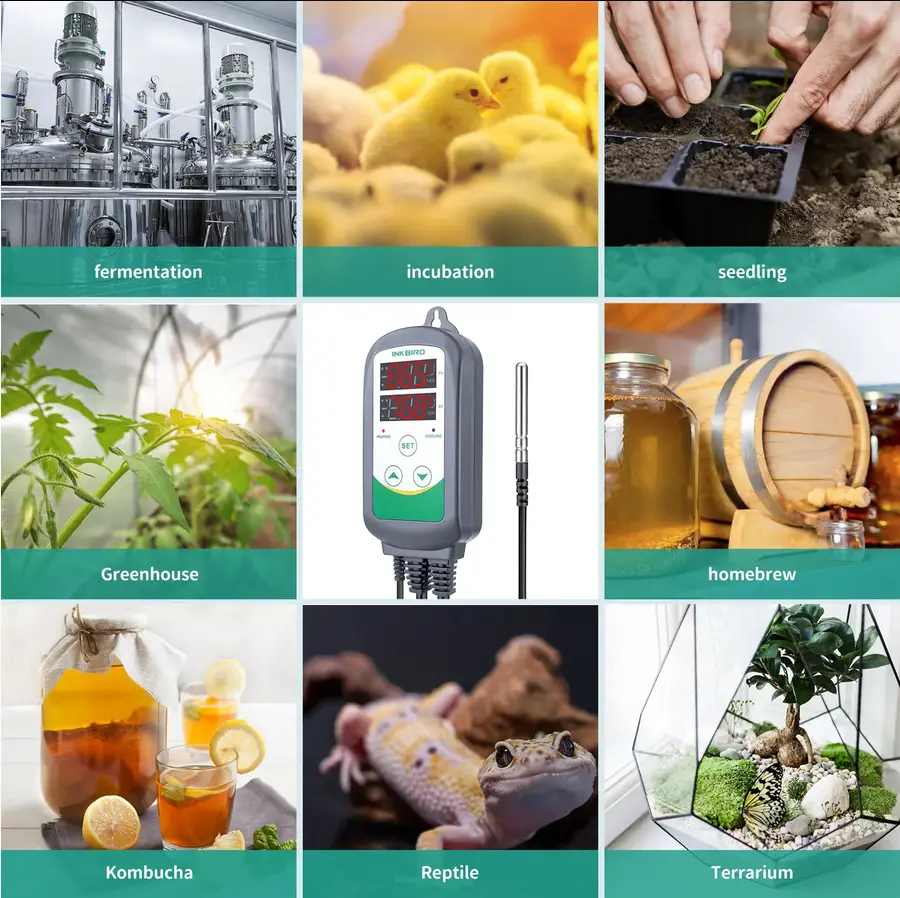
My first choice when it comes to various temperature controlling scenarios is the ITC-308 by INKBIRD, which I mentioned earlier. This is my favorite brand of thermostat due to its versatility and reliability. Below are some alternative options that you could use this thermostat for:
- Reptile Enclosures
- Aquariums
- Paludariums
- Plant Terrariums
- Home-brew
- Seedling
- Fermentation
- Incubation
- Greenhouses
- Kombucha
- And many more!
If you have some other hobbies that could use smart technology or temperature controllers, INKBIRD has three major product lines: smart controllers, food thermometers, and smart sensors. Check out their website, INKBIRD.com, to see if they have what you’re looking for!
Final Thoughts
Through my years of caring for reptiles, one truth has become abundantly clear: a reptile thermostat isn’t just a luxury; it’s a necessity. It’s the unsung hero that ensures my cold-blooded friends remain happy and healthy.
So, if you’re contemplating whether you need one, my experience tells me: you most certainly do.
Until next time!

Meet Brad, the creator behind Vivarium Vibes, where his deep connection with nature and animals truly comes to life.

